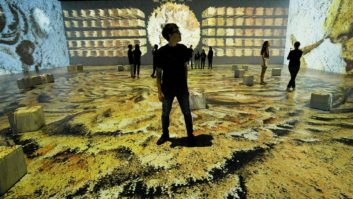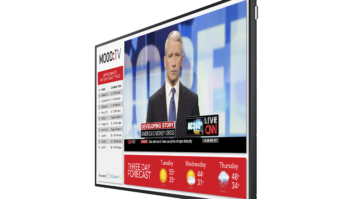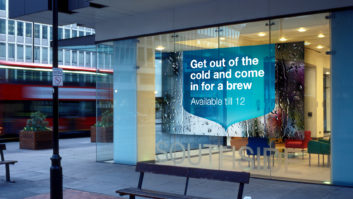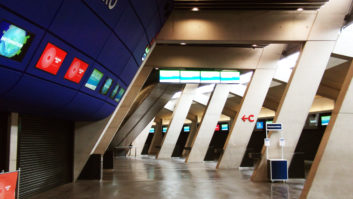
With margins on digital signage hardware falling, can system integrators add value to installations and generate ROI by advising on content creation and implementation? Steve Montgomery finds out.
The concept of digital signage has grown and developed over the past decade from virtually nothing to a major business. It has enabled the rapid and massive commercial growth of dedicated suppliers of hardware and software and attracted the attention of the largest display manufacturers, as well as enabling large advertising agencies to steer their corporate strategies away from static ‘analogue’ posters towards a digital future.
However, and it is painfully clear to many in the industry, the road has not been easy. Supplying a system that is capable of delivering impactful, immediate and relevant images and sound is just one element. An even larger, and more fraught, area of activity lies in the creation and distribution of the audiovisual content to run on screens.
“Designing and deploying a digital signage network with the wealth of available media players, displays and mounting options is a reasonably straightforward process these days. Integrators are offered a wide range of ever-cheaper solutions for every type of indoor and outdoor requirement and products have become far more robust and reliable,” points out Eddie Bance, sales and marketing director of Harp Visual Communications. The downside is that margins have fallen along with the costs of the equipment as competition increases.
“The real opportunity these days lies in structuring a network so that it operates dynamically and is totally robust and reliable,” he says. “For one-off signs with local management and content uploading this is obviously not an issue; the commercial opportunities for integrators to become involved are more prevalent in multi-site networks. There is no basic rule-of-thumb: it’s not really the size of the task but the diversity and complexity that would force the issue. Often networks require area-specific templates, for example betting shops with local racetracks, or local branding and offers.”
Growing the network
Mike Gibbs, consulting systems engineer at Appspace, agrees: “Integrators can get involved in any size of deployment. It’s more about how the signage benefits the viewer experience and what return the publisher of the content can achieve from it. From the integrator’s point of view, the ability to produce a system that can be replicated and expanded helps greatly in generating return on investment.”
Simon Carp, product manager at Onelan, points to another consideration: “Without a considered content strategy the messaging on screen will quickly become part of the wallpaper and be ineffective. With screens everywhere, people will not look at any that don’t show relevant content. To increase the chances of success the system should be configured to allow several people to contribute content while ensuring layout design, although scheduling and content publishing would be restricted to the system administrator. Sharing the task of content generation means more updates and more relevant content can be offered to the viewer.”
It generally falls to the integrator of the system to provide and set up that infrastructure in the first instance, using proprietary and common tools.
Content creation tools that enable end users to produce, publish and distribute new content to their estate of screens are a fundamental element of the commercial offering. Gibbs adds: “The method and production of content is a major consideration as it will affect the system implementation in many ways. To what extent the integrator gets involved really depends on their skills and the commercial model that can make or break even the best install. If the customer has a clear view on the content strategy the integrator can offer services to build and implement content assets within the CMS, but this relies on a clear understanding of the customer strategy. When that is not fully developed, perhaps because the end user is not conversant with the ways it can be related to their business model, a specialist consultative approach is needed. This is not about the tools available, but requires more knowledge and understanding of digital signage as a communication tool and medium.”
Creative thinking
Content creation can be handled by a wide variety of standard graphic tools. Large brands, particularly those in the retail sector, operate sophisticated and capable graphic design departments that use these tools to create material for their online presence and co-ordinate with national TV advertising. That content regularly becomes the source of material for their point-of-sale digital signage network.
“For traditional integrators, content creation and management may be a little out of their comfort zone so they may need to source an outside agency or employ an additional member of staff or freelance designer, depending on the scale of their plan,” Thomas Fraser-Bacon, marketing director at Allsee Technologies believes. “There are many content creation tools available on the market such as Adobe Creative Suite which includes packages that can help design static content as well as moving graphics or movies. Beyond these, pieces of proprietary software provided by system vendors, such as scheduling software or an online CMS, help manage the distribution of content onto the screen network.”
Integrated digital signage systems are invaluable across a wide range of applications. Dave Oades, managing director of Sedao, points out: “The major benefit of a system like ImageFlyer lies in the ability of end users to create and update a network of screens quickly, easily and effectively. For really engaging signage in corporate, healthcare, educational and hospitality markets the content needs to be dynamic and include a number of elements including welcome messages, live TV, recorded video and site news. Template-based systems enable end users to add their own styling and branding and then continuously update content by simply copying text or images into folders. This offers opportunities to integrators in setting up the system in the first place: creating the initial layouts on behalf of the user and configuring the system, rather than in future administration and content creation and update.
“In retail applications content is more likely to be based on single-screen video playback, often drawn from the retailer’s adverts and promotional videos. However, the retailer or brand will often pass ongoing network management and content transmission to a third party, which is an ideal opportunity for the integrator. They can then manage the whole system as one package: looking after hardware maintenance throughout the entire estate as well as administering content pushes and monitoring the performance of the media players.”
Allsee Technologies
Appspace content management
Harp visual communication solutions
Onelan digital signage and IPTV solutions
Sedao digital signage







